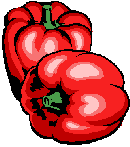.Com
Fruit Veg Fact
 |
 |
 |
 |
 |
|||
| HOME | FRUITS | VEGIES | KITCHEN |
SEASON |
FEEDBACK |
SEARCH |
|
|
.Com
|
|
|
DESCRIPTION |
A huge round or oval shape fruit and can weighed up to 15 kilograms. They have a light to dark hard green skin with stripes and a rich pink or red flesh with flat edible seeds.
HISTORY AND ORIGIN |
Watermelon belongs to the same family to the Squash and are thought to have originated in India.
BUYING AND STORAGE |
Select fresh Watermelon with good shape that feels heavy for its size. Tap Watermelon with fingers to hear the hollowness, the more hollow it is the better it is. Refrigerate whole Watermelon for 1 week. Cut and
PREPARATION AND USE |
Slice, cube or wedge. Can be eaten fresh on its own or added to fruit salad. Excellent to make fruit juice.
NUTRITIONAL INFORMATION |
Low in kilojoules, great for the weight conscious and a good source of vitamin C.
| MAJOR NUTRIENTS |
SERVING SIZE: 100 grm
| * ENERGY: | 96 kj | * IRON: | |
| * PROTEIN: | 3 grm | * POTASSIUM: | |
| * FAT: | .2 grm | * CALCIUM: | |
| * CARBOHYDRATE: | 5 grm | * VITAMIN A: | |
| * DIETARY FIBRE: | 1 grm | * VITAMIN B: | |
| * SODIUM: | 2 mg | * VITAMIN C: | 7 mg |
VARIETY |
SEEDLESS: A round medium-size Watermelon contains no seeds, sometimes it contains white soft edible seeds. Very sweet.
MINI LEE: A very small round Watermelon similar to the Seedless Watermelon and the flesh is dark red. Very sweet.
YELLOW CHAMPAGNE: A medium-size Watermelon and the flesh is yellow in colour. Very sweet.
RECIPE click here |
|
Send mail to fruitvegfact@iinet.net.au
with questions or comments about this web page.
|